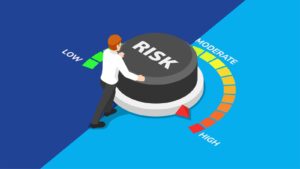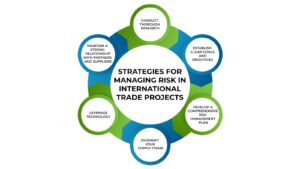
International trade projects can be complex and risky, with a range of factors that can impact success. These factors might include economic volatility, political instability, supply chain disruption, and cultural differences. As a result, it’s critical to develop effective risk management strategies to minimize risk and ensure the success of your international trade projects. In this blog, we’ll explore some strategies for managing risk in international trade projects.

- Conduct thorough research: One of the most important strategies for managing risk in international trade projects is to conduct thorough research. This might involve researching the target market, including cultural and legal differences, as well as researching potential partners or suppliers. By conducting thorough research, you can gain a better understanding of the risks and opportunities associated with the project, and develop a more informed strategy for managing those risks.
- Establish clear goals and objectives: It’s important to establish clear goals and objectives for your international trade project, as this can help guide decision-making and minimize risk. This might include setting specific timelines, defining target markets and customer segments, and identifying key performance indicators. By establishing clear goals and objectives, you can ensure that all stakeholders are aligned and working towards the same objectives.
- Develop a comprehensive risk management plan: A comprehensive risk management plan is critical for managing risk in international trade projects. This plan should identify potential risks and provide strategies for mitigating those risks. It might include contingency plans for supply chain disruption, currency fluctuations, or political instability, as well as strategies for managing cultural differences or communication challenges.
- Diversify your supply chain: A key strategy for managing risk in international trade projects is to diversify your supply chain. This might involve identifying multiple suppliers in different geographic locations, or developing relationships with suppliers that have a proven track record of reliability. By diversifying your supply chain, you can minimize the risk of supply chain disruption or quality issues.
- Leverage technology: Technology can be a valuable tool for managing risk in international trade projects. This might include using data analytics to monitor supply chain performance, or leveraging cloud-based platforms for collaboration and communication. By leveraging technology, you can improve visibility and transparency across the supply chain, and respond quickly to potential risks or issues.
- Maintain a strong relationship with partners and suppliers: Finally, maintaining a strong relationship with partners and suppliers is critical for managing risk in international trade projects. This might involve regular communication, building trust through transparency, and working together to identify and mitigate potential risks. By maintaining strong relationships with partners and suppliers, you can reduce the likelihood of issues arising and ensure that everyone is working towards the same objectives.
In conclusion, managing risk in international trade projects requires a comprehensive and proactive approach. By conducting thorough research, establishing clear goals and objectives, developing a comprehensive risk management plan, diversifying your supply chain, leveraging technology, and maintaining strong relationships with partners and suppliers, you can minimize risk and ensure the success of your international trade projects.






